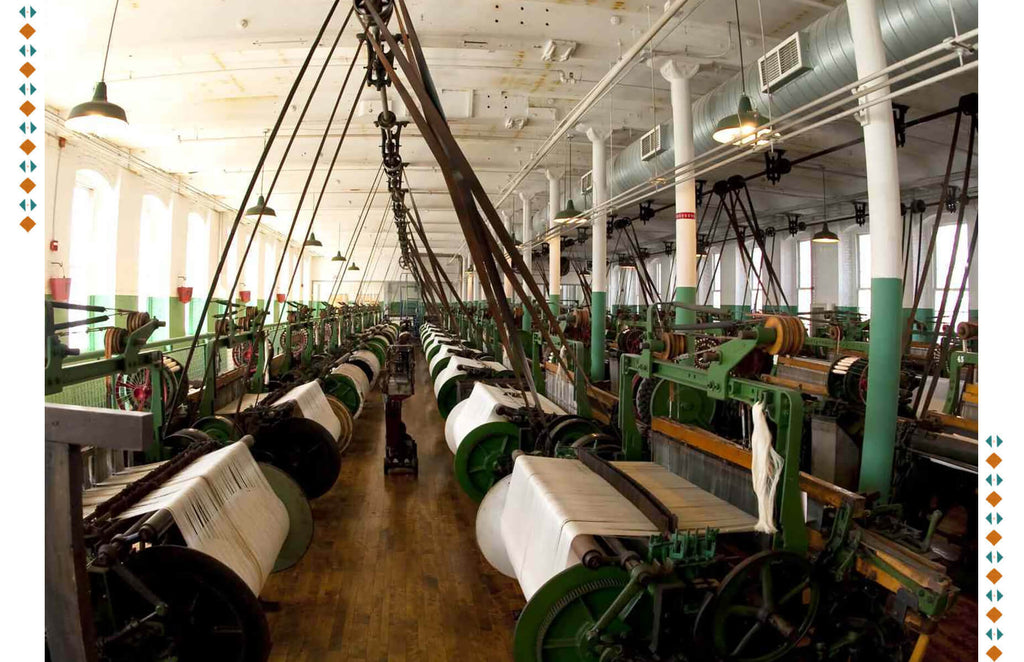The textile industry is one of the most prominent industries in the world. The industry exports several million of clothing annually to other countries with the help of over five lakh workers. Numerous people were involved in handlooms for small-scale production before the industrial revolution.
It is said that prior to the establishment of the factory system, several people were working in spinning and weaving. How does that revolutionize?
Let’s learn about the transformation and how it is pertaining in present times.
Which Sectors Saw an Increase in Production Because of the Industrial Revolution?

One of the first industries hit hard by the advent of the industrial revolution was the textile market. Around 1760, there were just two or three factories in Manchester, but that number grew dramatically over the next several decades.
By 1835, England and Scotland had more than a thousand cotton mills, the vast majority of which used John Kay's flying shuttle loom. These mills contributed to the displacement of artisans who had been hand-weaving in their homes and workplaces for decades.
The domestic system began to quickly decline as a result of industrial production's superior efficiency compared to that of a family working together to attain a domestic goal. The development of new technologies also led to the rise of machine makers who choose to use steam engines and water turbines in their products.
Changing Face of the Textile Industry

Many things affected the textile industry during the industrial revolution. A new division of labor was implemented between spinning and weaving to increase output and decrease turnaround time.
Previously, water-powered mills were largely used by handlooms in families or towns; however, machines allowed power to be created away from rivers or streams, hence increasing output to factories and simplifying cotton shipment. In addition, faster rotations were possible because of the improved machinery, and each part could now create more complex structures than ever before. Printed fabrics, for example, gained popularity in the nineteenth century because of technological advancements.
Revolutionary Creations That Changed the Face of the Textile Industry

The textile business underwent radical change as a result of the industrial revolution. It significantly increased fabric production by inventing new technology that allowed for hitherto impossible levels of efficiency. The following sections provide an overview of three of the most exciting technologies that have caused a major disruption in the textile industry:
- The cotton gin simplified the process of separating the cotton seed from fibers, which led to cotton's rise to prominence as a textile.
- Fabric production increased drastically with the invention of the spinning jenny, which greatly facilitated the production of thread without necessitating a large increase in the labor force.
- The introduction of printing presses allowed for faster duplication of printed textiles than was previously possible, reducing the time spent on each canvas while increasing output. They were also far cheaper than earlier versions, which boosted sales considerably.
The Impact of Textile Production on the Industrial Revolution

The textile industry played an essential role in the development of the industrial revolution. The enormous increase in production may be attributed to the fact that people now have more time on their hand's thanks to the advent of factories and machines.
Large textile mills started to appear in England, Scotland, and the United States, providing thousands of industrial jobs, and people produced more fabric than ever before. Some interesting information you should know about this is as follows:
- Fabric output increased in factories as machines replaced labor-intensive handlooms.
- As production grew, many workers lost their jobs in the domestic system, but fabric manufacturers were able to provide them with new positions.
- The increased supply and decreased demand resulted in reduced prices, making it more affordable for more buyers.
Changing Roles in the Textile Industry

When the 18th century gave way to the 19th, the textile industry underwent a period of rapid change as a result of the introduction of new technologies and methods. Rapid industrialization occurred as a result of widespread mechanization.
The widespread adoption of these enormous brick industrial buildings may be attributed to the widespread replacement of handlooms in households and businesses with modern machinery that increased productivity by more than seventy times faster than certain artists could produce by hand. Since workers were now working full-time with time off on Sundays and holidays, this led to a rise in living standards as a consequence of increased pay and the availability of better job possibilities.
Epilogue
A new division of labor decreased domestic production, and improved technology all contributed to the textile industry's first transformation during the industrial revolution. Later, the textile industry grew more rapidly into a factory-style structure that has allowed it to thrive in the modernized world we live in today by way of printing presses and other novel procedures.
FAQ
What was the revolution in the textile industry?
The industrial revolution was a significant revolution that took place within the textile industry.
How did the industrial revolution affect fashion?
The industrial revolution greatly influenced the fashion industry. Knitted and woven cloth with a finer gauge might be produced by machines than by most people at home. The sewing machine was one invention of the industrial revolution that streamlined and reduced the cost of making clothing.
We also happen to be a magnet for suggestions, and would love to catch yours….throw us yours on hello@fabriclore.com





